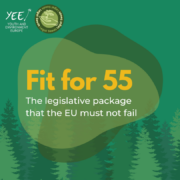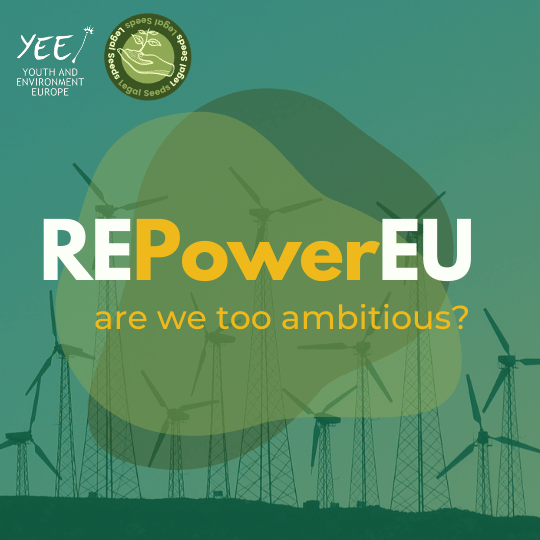
Written by
Contents
Visual summary










Learn more about the project
Share this article
What is Fit For 55?
The European Green Deal significantly raises the EU’s climate ambition to deliver on its multilateral commitments under the Paris Agreement (2015) and put it on a path toward climate neutrality. The FF55 is a set of twelve proposals presented by the European Commission on 14th July 2021 that aims to revise and update EU climate policies with the objective to make a legal obligation for all the EU countries to reduce greenhouse gasses (GHG) to 55% compared to 1990 by 2030. It implements and meets the longer-term Green Deal, by aligning with the EU objective of reaching climate neutrality by 2050.
The aim is to guarantee a just and socially fair transition and strengthen innovation and competitiveness of EU industry while ensuring a level playing field vis-à-vis third country economic operators. Furthermore, it is used as a tool for the EU to lead the way in the global fight against climate change.
The Fit for 55 package’s proposals were presented and discussed at a technical level within the Council’s working parties responsible for the policy area concerned before they landed on the table of EU member states. Discussions are held to prepare the ground for an agreement on the proposals among the 27 member states. EU ministers, in various Council configurations, then exchanged views and seeked an agreement on a common position on the proposals. This forms the basis on which the presidency of the Council then engaged with the European Parliament in negotiations to find a common agreement in view of the final adoption of the legislative acts.
The Fit for 55 package was submitted to the Council in July 2021 and it is being discussed across several policy areas, such as environment, energy, transport, and economic and financial affairs. Concretely, the FF55 is composed of different rules regulating climate-related sectors and includes a high variety of sectors, among which the: Renewable Energy Directive (RED); The Emission Trading System (ETS); The Effort Sharing Regulation (ESR); The Land Use, Land Use Change, and Forestry Regulation (LULUCF).
2019, 2020 & 2021 – How do we achieve climate neutrality?
The Fit for 55 takes its sources in 2019 when the EU leaders endorsed the 2050 Climate neutrality objective. Poland was the only one to express reservations on the subject. Following this resolution, in October 2020 the EU leaders discussed the EU’s Climate ambition for 2030 and the Council adopted conclusions on the EU biodiversity strategy for 2030.
Things accelerated in April 2021 when the Council and the Parliament reached a provisional agreement of reducing greenhouse gasses (GHG) to 55% compared to 1990 by 2030. On 20 July 2021, EU environment ministers discussed FF55 during an informal meeting, and from this date, the official discussion started.
The first formal minister debate took place on October 6 and was focused on the impact of the proposals on citizens, emissions trading to buildings, and road transports.
For the last meeting of the year 2021, the environment Council took note of a progress report prepared by the Slovenian presidency and held a policy debate on five of the files in FF55 which are:
- revision of the greenhouse gas emission allowance trading scheme (EU ETS)
- revision of the regulation on binding annual greenhouse gas emission reductions by member states (effort sharing regulation)
- revision of the regulation on greenhouse gas emissions and removals from land use, land use change and forestry (LULUCF)
- revision of rules for CO2 emission performance standards for new cars and vans
- regulation establishing a social climate fund
*Infographic – Fit for 55: how the EU will turn climate goals into law
2022 – securing the energy supply
On 24 February 2022, the Russian invasion of Ukraine started. Since then, the EU has been facing the challenge of security of energy supply due to its dependency on Russian gas, and as 45% of natural gas consumed by the EU comes from Russia, it was quickly necessary to find alternative sources and therefore, by force of circumstance, to review the FF55 energy plan.
Thus, within the Parliament, ongoing discussions target the ways in which these rules can be amended, changed, and updated to meet the climate policy objectives. The European Commission presented on March 8 the idea of coming up with a new project which aims at phasing out Russian fossil fuels and becoming more autonomous and independent regarding its energy supply and security. The plan was well received by EU leaders, who signed the Versailles declaration. They all agreed on the necessity to make the EU independent from Russian energy imports as soon as possible. On May 18, the Commission presented the REPowerEU plan, and a week after the EU Energy Platform Task Force was established to secure alternative supplies.
On 29 June 2022, the Council of the EU adopted a common position on the package presented in July 2021 by the Commission. A general approach under the French Presidency was agreed on, which differs in significant ways from the European Parliament’s Committee for Industry, Research, and Energy (ITRE) report.
More precisely, Member States adopted a common approach to the EU emissions trading system (EU ETS), effort-sharing between member states in non-ETS sectors (ESR), emissions and removals from land use, land-use change and forestry (LULUCF), the creation of a social climate fund (SCF) and new CO2 emission performance standards for cars and vans.
The Council supports a binding renewable energy sources (RES)target of only 40 % by 2030, reflecting the Commission’s original proposal (July 2021). The general approach offers Member States the flexibility to choose between a 13% reduction in GHG intensity or a 29 % share of RES in the final energy consumption in the transport sector by 2030. The general approach proposes lower sub-targets for mainstreaming RES in heating and cooling (+0.8% annually until 2026 and +1.1 % thereafter) and industry (+1.1% annually), but also requires that 35 % of the hydrogen used in the industry should come from RFNBOs by 2030, rising to 50 % by 2035.
This common position is called “general approaches”.
The year 2022 ended up with endless negotiations regarding nuclear power. The socialists and greens support banning atomic power, but some countries, more nuclear-dependent such as France, are opposing the above positions towards atomic energy. Finally, on July 6, the Parliament voted to record nuclear power as renewable energy. The chapter on renewable energies of FF55 is therefore greatly impacted since the threshold to be met will now include not only solar and wind energy but also renewable nuclear and gas.
2023 – planning ahead
Even though 2023 just started 3 months ago, the discussion around the possibility of setting national sustainable aviation fuel (SAF) is still in process. Indeed the aviation industry is one of the main parts of Fit For 55. Under this regulation, all planes departing from an EU airport will have to refuel as they become available with sustainable aviation fuel (CAD) — low-carbon alternatives to kerosene made from advanced biofuels and hydrogen-derived green synthetic fuels.
The European Parliament and the Council do not agree on the percentage of CAD to be imposed — the Parliament wants 85% by 2050, while the Council sticks to the 63% proposed by the Commission — and on the matters first to be designated as “sustainable”.
The inclusion of nuclear as a potential energy source to create synthetic fuels was the red line for Socialist (S&D) and Green (Greens/EFA) MEPs.
FuelEU Maritime, the sibling of ReFuelEU Aviation, will also be negotiated in 2023.
Unlike the aviation fuel law, FuelEU does not mandate the type of fuel that must be used in ships. Rather, it sets increasingly strict carbon intensity limits that must be respected.
However, green-minded legislators are concerned that giving the shipping industry carte blanche will see them choose the cheapest rather than the greenest option to meet the targets. Specifically, the option to fuel ships with liquefied natural gas – a fossil fuel – up to 2030 has proven controversial.
Finally, concerning the automotive sector, new thermal engine cars will be banned from sale by 2035. However, the lack of charging stations creates a significant problem for the development of electric cars.
Both the private sector and national governments are working to increase the availability of charging points. In Brussels, the issue is addressed through the Alternative Fuels Infrastructure Regulation (AFIR).
AFIR sets out requirements for the number of charging stations along the EU’s main transport corridors and aims to make it easier to pay for charging, particularly when crossing into another EU country.
Access to Justice in the FF55
Other than being crucial that MEPs find fast, common agreements on these, it is also likely crucial that Member States (MSs) implement and enforce the package. Once adopted by the EU, the package will be in the hands of MSs, which have the responsibility to implement the updates.
The Aarhus Convention, signed in 1998, sets three important pillars —access to information, public participation, and access to justice — which are the cornerstones of environmental and climate governance in Europe. As also parties of the Convention, EU member states and the EU itself have an obligation to implement all its pillars.
Among these pillars, ensuring that EU citizens and NGOs have the right of access to justice is essential to make sure that member states are held accountable in case of disrespect of environmental and climate objectives. Despite the fact that regulations have a direct effect on Member States’ laws, access to justice in environmental matters is still very limited. The right of access to justice has been therefore subject to strong advocacy work from EU environmental NGO. According to them, it is crucial to have a liability mechanism open to civil society for holding MSs accountable for any violation: the climate emergency does not allow delays in the implementation of measures.
With the massive work around the FF55, there is a concrete possibility to include access to justice provisions within EU climate rules and ensure the empowerment of civil society in challenging MSs when not complying with the agreed targets. As a matter of fact, there is neither democracy nor a green Europe without sound and coherent access to justice: the FF55 must not be the exception.
Finally, it is important to remember that FF55 is still open for updates, the negotiations are still in process so NGOs can and must put pressure on Member States to make this agreement sustainable and greener.
More articles

Rivers – anywhere you are in Europe, there must be a river not far from you. Ancient Greeks would marvel at rivers

The Environmental Law Team of YEE actively participated in the 15th Task Force on Access to Justice in Geneva, sharing valuable insights.

The discussion within the EU around the Fit For 55 legislative package is at the core of the EU’s current action on

If exiting from the Russian fossil fuels, gas and coal import is a necessity, should it be then done at all costs?







 YEE aims to unite environmental youth non-profit organisations in Europe in order to enhance international cooperation, increase knowledge about the climate crisis, raise awareness of environmental problems and to strengthen participation of youth in environmental decision-making.
YEE aims to unite environmental youth non-profit organisations in Europe in order to enhance international cooperation, increase knowledge about the climate crisis, raise awareness of environmental problems and to strengthen participation of youth in environmental decision-making.

